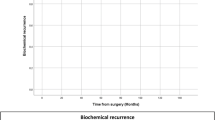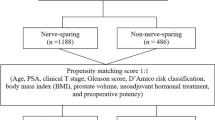Abstract
D’Amico high risk prostate cancer is associated with higher incidence of extra prostatic disease. It is recommended to avoid nerve sparing in high risk patients to avoid residual cancer. We report our intermediate term oncologic and functional outcomes in patients with preoperative D’Amico high risk prostate cancer, who underwent selective nerve sparing robot-assisted radical prostatectomy (RARP). Between Jan 2008 till June 2013, 557 patients underwent RARP for D’Amico high risk prostate cancer. The criteria for nerve sparing were as follows—complete: non palpable disease with <3 cores involvement on prostate biopsy; partial: non palpable disease with <4 cores involvement on prostate biopsy; none: clinically palpable disease with ≥4 cores involvement on prostate biopsy and intraoperative visual cues of locally advanced disease (loss of dissection planes, focal bulge of prostatic capsule). Degree of nerve sparing (NS) was graded intraoperatively by the surgeon independently at either side as side specific margins were assessed to predict subjectivity of the intraoperative judgment. Various data were collected and analyzed. Of 557 patients who underwent RARP 140 underwent complete (group 1), 358 patients underwent partial (group 2), and 59 patients underwent non-nerve-sparing procedure (group 3). There were no difference in preoperative characteristic between the groups (p = 0.678), but group 3 had higher Gleason score sum (p = 0.001), positive cores on biopsy (p = 0.001) and higher t stage (p = 0.001). Postoperatively Extra prostatic extension (p = 0.001), seminal vesicle invasion (p = 0.001), and tumor volume (p < 0.001) were higher in Group 3. Side specific positive surgical margins (PSMs) rates were higher for non-nerve-sparing compared to partial and complete nerve sparing RARP (p < 0.001; overall PSMs = 25.2 %). On univariate and multivariate analysis, nerve sparing did not affect PSMs (p > 0.05). The overall biochemical recurrence (BCR) rate at mean follow-up of 24.3 months was 19.21 %. The continence rate at 3 month was significantly higher in complete NS group in comparison to non-NS group (p = 0.020), however, this difference was not statistically significant at 1 year. Similarly, mean time to continence was significantly lower in complete NS group in comparison to non-NS group (p = 0.030). The potency rate was significantly higher and mean time to potency was significantly lower in complete NS group in comparison to non-NS group (p = 0.010 and 0.020, respectively). In high risk prostate cancer patients, selective nerve sparing during RARP, using the preoperative clinical variables (clinical stage and positive cores on biopsy) and surgeon’s intraoperative perception, could provide reasonable intermediate term oncologic, functional outcomes (continence and potency) with acceptable perioperative morbidity and positive surgical margins rate. Use of these preoperative factors and surgeon’s intraoperative judgment can appropriately evaluate high risk prostate cancer patients for nerve sparing RARP.
Similar content being viewed by others
References
Minino AM, Smith BL (2001) Deaths: preliminary data for 2000. Natl Vital Stat Rep 49:1–40
Crawford ED (2003) Epidemiology of prostate cancer. Urology 62:3–12
Jani AB, Johnstone PA, Liauw SL, Master VA, Brawley OW (2008) Age and grade trends in prostate cancer (1974–2003): a surveillance, epidemiology, and end results registry analysis. Am J Clin Oncol 31:375–378
Edwards BK, Noone AM, Mariotto AB et al (2014) Annual report to the nation on the status of cancer, 1975–2010, featuring prevalence of comorbidity and impact on survival among persons with lung, colorectal, breast, or prostate cancer. Cancer 120(9):1290–1314
Yossepowitch O, Eggener SE, Serio AM et al (2008) Secondary therapy, metastatic progression, and cancer specific mortality in men with clinically high risk prostate cancer treated with radical prostatectomy. Eur Urol 53:950–959
Yuh B, Artibani W, Heidenreich A et al (2014) The role of robot assisted radical prostatectomy and pelvic lymph node dissection in the management of high risk prostate cancer: a systematic review. Eur Urol 65:918–927
Yuh BE, Ruel NH, Mejia R et al (2012) Robotic extended pelvic lymphadenectomy for intermediate and high risk prostate cancer. Eur Urol 61:1004–1010
D’Amico AV, Whittington R, Malkowicz SB et al (1999) Pretreatment nomogram for prostate-specific antigen recurrence after radical prostatectomy or external-beam radiation therapy for clinically localized prostate cancer. J Clin Oncol 17:168–172
D’Amico AV, Whittington R, Malkowicz SB et al (1998) Biochemical outcome after radical prostatectomy, external beam radiation therapy, or interstitial radiation therapy for clinically localized prostate cancer. JAMA 280:969–974
Shikanov SA, Thong A, Gofrit ON et al (2008) Robotic laparoscopic radical prostatectomy for biopsy Gleason 8 to 10: prediction of favorable pathologic outcome with preoperative parameters. J Endourol 22:1477–1481
Jayram G, Decastro GJ, Large MC et al (2011) Robotic radical prostatectomy in patients with high risk disease: a review of short term outcomes from a high volume centre. J Endourol 25(3):455–457
Heidenreich A, Bastian PJ, Bellmunt J et al (2014) EAU guidelines on prostate cancer. Part 1: screening, diagnosis, and local treatment with curative intent—update 2013. Eur Urol 65:124–137
D’Amico AV, Chen MH, Renshaw AA et al (2008) Androgen suppression and radiation vs. radiation alone for prostate cancer: a randomized trial. JAMA 299:289–295
Taylor LG, Canfield SE, Du XL (2009) Review of major adverse effects of androgen deprivation therapy in men with prostate cancer. Cancer 115:2388–2399
Schmitges J, Trinh QD, Walz J et al (2011) Surgery for high risk localized prostate cancer. Ther Adv Urol 3(4):173–182
Connolly SS, Cathcart PJ, Gilmore P et al (2011) Robotic radical prostatectomy as the initial step in multimodal therapy for men with high risk localized prostate cancer: initial experience of 160 men. BJUI 109:752–759
Hou GL, Yun L, Di JM et al (2015) Predictors of urinary continence recovery after modified radical prostatectomy for clinically high risk prostate cancer. Urol Oncol 12(1):2021–2027
Lawrentschuk N, Trottier G, Kuk C et al (2010) Role of surgery in high risk localized prostate cancer. Curr Oncol 17(2):S25–S32
Ficarra V, Cavalleri S, Novara G, Aragona M, Artibani W (2007) Evidence from robot-assisted laparoscopic radical prostatectomy: a systematic review. Eur Urol 51:45–56
Ficarra V, Borghesi M, Suardi N et al (2013) Long-term evaluation of survival, continence and potency (SCP) outcomes after robot-assisted radical prostatectomy (RARP). BJU Int 112(3):338–345
Ficarra V, Novara G, Artibani W, Cestari A, Galfano A, Graefen M, Guazzoni G, Guillonneau B, Menon M, Montorsi F, Patel V, Rassweiler J, Van Poppel H (2009) Retropubic, laparoscopic, and robot-assisted radical prostatectomy: a systematic review and cumulative analysis of comparative studies. Eur Urol 55:1037–1063
Coelho RF, Rocco B, Patel MB (2010) Retropubic, laparoscopic, and robot-assisted radical prostatectomy: a critical review of outcomes reported by high-volume centers. J Endourol 24(12):2003–2015
Srivastava A, Chopra S, Pham A (2013) Effect of a risk-stratified grade of nerve-sparing technique on early return of continence after robot-assisted laparoscopic radical prostatectomy. Eur Urol 63(3):438–444
Yossepowitch O, Briganti A, Eastham JA et al (2014) Positive surgical margins after radical prostatectomy: a systematic review and contemporary update. Eur Urol 65:303–313
Punnen S, Meng MV, Cooperberg MR et al (2013) How does robot assisted radical prostatectomy compare with open surgery in men with high risk prostate cancer? BJUI 112:E314–E320
Lavery HJ, Nabizada PF, Carlucci JR et al (2012) Nerve sparing robotic prostatectomy in preoperatively high risk patients is safe and efficacious. Urol Oncol 30:26–32
Casey JT, Meeks JJ, Greco KA et al (2009) Outcomes of locally advanced (T3 or greater) prostate cancer in men undergoing robot assisted laparoscopic prostatectomy. J Endourol 23:1519–1522
Patel VR, Tully AS, Holmes R et al (2005) Robotic radical prostatectomy in the community setting—the learning curve and beyond:initial 200 cases. J Urol 174:269–272
Ko YH, Coelho RF, Sivaraman A et al (2013) Retrograde versus antegrade nerve sparing during robot-assisted radical prostatectomy: which is better for achieving early functional recovery? Eur Urol 3(1):169–177
Patel VR, Coelho RF, Palmer KJ et al (2009) Periurethral suspension stitch during robot assisted laparoscopic radical prostatectomy: description of the technique and continence outcomes. Eur Urol 56:472–478
Coelho RF, Chauhan S, Orvieto MA et al (2011) Influence of modified posterior reconstruction of the rhabdosphincter on early recovery of continence and anastomotic leakage rates after robot assisted radical prostatectomy. Eur Urol 59:72–80
Sagalovich D, Calaway A, Srivastava A et al (2012) Assessment of required nodal yield in a high risk cohort undergoing extended pelvic lymphadenectomy in robotic assisted radical prostatectomy and its impact on functional outcomes. BJUI 111:85–94
Wang JG, Huang J, Chin AI et al (2014) RARP in high risk prostate cancer: use of multi-parametric MRI and nerve sparing techniques. Asian J Androl 16:715–719
Author information
Authors and Affiliations
Corresponding author
Ethics declarations
Conflict of interest
There is no conflict of interest for the authors Anup Kumar, Srinivas Samavedi, Vladimir Mouraviev, Anthony S. Bates, Bernardo Rocco, Rafael F. Coelho and Vipul R. Patel.
Research involving human participants and/or animals
Human participants.
Informed consent
All procedures followed were in accordance with the ethical standards of the responsible committee on human experimentation (institutional and national) and with the Helsinki Declaration of 1975, as revised in 2000 (5). Informed consent was obtained from all patients for being included in the study.
Rights and permissions
About this article
Cite this article
Kumar, A., Samavedi, S., Bates, A.S. et al. Safety of selective nerve sparing in high risk prostate cancer during robot-assisted radical prostatectomy. J Robotic Surg 11, 129–138 (2017). https://doi.org/10.1007/s11701-016-0627-3
Received:
Accepted:
Published:
Issue Date:
DOI: https://doi.org/10.1007/s11701-016-0627-3




